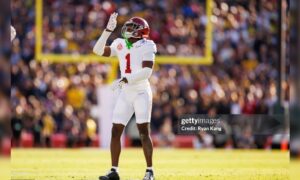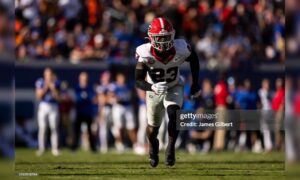By Jeremy Hritz
It’s the end of June and Mike Wallace still has yet to sign a contract with the Steelers. Although teammate Ike Taylor has now said on two occasions that Wallace will be in camp, there have not been any formal updates on the progress of a new contract.
Back on March 21st, 49ers beat writer Matt Barrows reported that a 49er’s team source said they inquired about Wallace but were turned off because “he reportedly wanted” a contract that exceeded the one of Larry Fitzgerald, which is worth $128.5 million over eight years. Whether or not that is true we just don\’t know. The Steelers do not have a reputation for paying big money for wide receivers, and in fact, they have a history of letting them walk (see Yancey Thigpen, Antwaan Randle El, Nate Washington and Plaxico Burress). If Barrows’ report is accurate, it could be the primary reason for the delay.
The question has since been debated of whether or not Wallace is worth such a contract, but Steelers Depot reader Tim asked an interesting question via email: does Antonio Brown make Wallace less valuable to the Steelers?
To draw a valid conclusion here, we need to look at other top receivers in contract years and the second and third receivers on those teams. For the purpose of this article, we will take a brief look at Larry Fitzgerald, Andre Johnson, and Calvin Johnson. The table below provides a look at these three receivers, along with the second and third leading receivers from their teams.
| Team | Receiver | Stats Prior to Contract Year | Date of Contract | Contract Length/Contract Value |
|---|---|---|---|---|
| Arizona | Larry Fitzgerald (2010) | 174 targets, 90 receptions, 1137 yards, 6 touchdowns | 8/20/2011 | 8 years, $128.5 million |
| Arizona | Steve Breaston (2010) | 88 targets, 47 receptions, 718 yards, 1 touchdown | N/A | N/A |
| Arizona | Early Doucet (2010) | 58 targets, 26 receptions, 291 yards, 1 touchdown | N/A | N/A |
| Houston | Andre Johnson (2009) | 170 targets, 101 receptions, 1569 yards, 9 touchdowns | 8/5/2010 | 7 years, $73.5 million |
| Houston | Kevin Walter (2009) | 70 targets, 53 receptions, 611 yards, 2 touchdowns | N/A | N/A |
| Houston | David Anderson (2009) | 54 targets, 38 receptions, 370 yards, 0 touchdowns | N/A | N/A |
| Detroit | Calvin Johnson (2011) | 158 targets, 98 receptions, 1681 yards, 16 touchdowns | 3/14/2012 | 8 years, $132 million |
| Detroit | Nate Burleson (2011) | 110 targets, 73 receptions, 757 yards, 3 touchdowns | N/A | N/A |
| Detroit | Titus Young (2011) | 84 targets, 48 receptions, 607 yards, 6 touchdowns | N/A | N/A |
| Pittsburgh | Mike Wallace (2011) | 113 targets, 72 receptions, 1193 yards, 8 touchdowns | N/A | N/A |
| Pittsburgh | Antonio Brown (2011) | 123 targets, 69 receptions, 1108, 2 touchdowns | N/A | N/A |
| Pittsburgh | Hines Ward (2011) | 63 targets, 46 receptions, 381 yards, 2 touchdowns | N/A | N/A |
A few points of interest leap out in this table. Firstly, Wallace’s production is very comparable to Fitzgerald’s in his contract year (Fitzgerald: 93/1137/6-Wallace: 72/1193/8). However, when looking at the number two and three receivers for Arizona from Fitzgerald’s contract year, it is apparent those players, Breaston and Doucet, were not as effective as Brown and Ward. So even with Fitzgerald drawing primary coverage, Breaston and Doucet combined could not equal Brown’s performance (it has to be noted that they had Derek Anderson and John Skelton throwing the ball). This makes a case for Brown’s effectiveness.
When looking at Andre Johnson and Calvin Johnson in their contract years, their stat lines eclipse that of Wallace. Andre Johnson outgained Wallace by 376 yards and three touchdowns, while Calvin Johnson outgained him by 488 yards and ten touchdowns. The second and third receivers for Houston did not achieve what Brown and Ward did, yet Burleson and Young had more receptions and seven more touchdowns for the Lions. The following table compares second and third receivers.
| Second/Third Receivers | Targets/Receptions | Yards | Touchdowns |
|---|---|---|---|
| Steelers (Brown, Ward) | 186/115 | 1489 | 2 |
| Lions (Burleson, Young) | 194/121 | 1364 | 9 |
| Cardinals (Breaston, Doucet) | 146/73 | 1009 | 2 |
| Texans (Walter, Anderson) | 124/91 | 981 | 2 |
Is Wallace asking for too much money? When considering the performance of Brown, the answer to that question may be yes. While the counter argument will be made that Wallace absorbed coverage that freed up Brown, what to make of his production after he established himself as a legitimate receiver?
Another point to made is that you Wallace’s drop in production cannot completely be attributed to coverage schemes. If bolstered coverage always accounts for a decrease in production, then what to make of Andre Johnson, whom with less-than-stellar number two and three receivers, was still able to rack up nearly 1600 yards and nine touchdowns (I’ll acknowledge Owen Daniels here who had 40 receptions for 509 yards and five touchdowns, but tight ends are not our focus).
So what does it all mean in the end? The Steelers probably feel confident about the abilities of Brown to be the primary receiver in the event that Wallace doesn’t sign long-term, considering the depth that they have at the position. Consequently, they are not willing to part with exorbitant money to pay him in the range of any of the receivers mentioned above. While Wallace has proven his value by stretching the field, he has not proven himself to be a complete receiver like Fitzgerald or either of the Johnsons.
The amount of money that Wallace allegedly wants would make him the highest paid Steeler, but in reality, only the most important and critical players should be paid as such. While Wallace is a tremendous talent that has made several huge plays in his first three years, he is not as vital to the team as is Ben Roethlisberger, Troy Polamalu, or LaMarr Woodley. When either of these players misses a game, it impacts the win/loss column, and Wallace just isn’t in that category yet.







